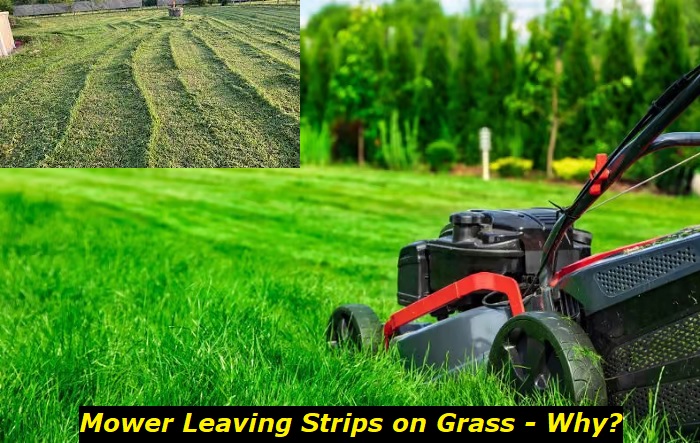3 Blade Mower Leaving Strips: What's the Problem and Fixes?
Strips of uncut grass on your lawn are a frustrating experience to homeowners but the solution to the problem could be as simple as operating the mower itself. In this article, we shall explain the various reasons that lead to your mower streaking and how to fix all these problems.
Typically, streaking is a common problem with lawnmowers and can emanate from human errors and poor mower maintenance. Though it can be brought by a faulty machine, it is mainly associated with errors of commission and omission by the mower operator.

The most common causes of uncut grass strips include.
- Damaged blades
- Poor engine performance
- Clogged deck
- Very low throttle
- Very high lawn mower speed
- Low pressure in tires
- Operator errors
A majority of these problems arise from operator errors rather than mechanical issues. Before we delve into the specifics of these problems, it is important to understand the various types of blades that are common with mowers. The blade is the most critical part responsible for efficient and accurate cuts on your lawn.
Blade Types
Mowing blades are different and the choice depends on your needs and climate. Having a general understanding of these blades and the existing differences might be all you need to avoid ugly lawns after a mowing job. The blades can be categorized as follows-
1) Straight Blades
These are the most common and are almost standard in most of the mowers they are straight with a curvature at the end that allows air flow for suction. The blades' spin 'cuts and suck' the grass for a clean and accurate cut.
2) Low-Lift Blades
The blades are 3-4 inches long and have a low suction force with fewer curly edges compared to the straight blades. Due to the low suction, they keep the grass low and also force the dust to settle on the ground, hence the name low-lift. They operate quietly and have low energy demand.
3) The High Lift Blades
These are long blades with distinct vertically-angled edges allowing maximum vertical suction that lifts the grass up and straight for accurate cutting. They produce a strong airflow force that ensures all debris is pushed out of the chute.
4) Mulching Blades
They have curved and sharp cutting edges that cut and chop the grass into very small pieces that are then strewn onto the lawn.
5) Gator Blades
They are similar to the mulching blades but have unique modified curves and teeth for finer chopping. The modified curves increase their suction force which pulls the grass up and directs it towards the sharp cutting edge.
Blade Problems
Uncut strips on your lawn are mainly a result of blade-related issues. Ensure to check your blades for various defects or mal-alignments that may be the cause of this problem. Defects such as bends, loose bolts, improper installation, and broken edges may arise as the blade hits unforeseen obstacles such as stones, stumps, and pipes. Since blades rotate at a very high speed (50 turns per second), such hits are likely to damage them.
1) Misaligned
The misalignment may be due to improper installation, loose bolts, or warping as a result of hitting something on the ground. This leads to angled cutting which is not effective in trimming the grass to the required cut.
Solution
Check the blades and ensure they are properly aligned or tightened. Adjust them where necessary, tighten the bolts, or if need be, have them removed and straightened out before re-fixing them properly. If they have serious irreparable damage, have them replaced?
2) Wrong Blade Orientation
If a blade is fixed wrongly (backways), it will not be able to cut the grass on the lawn.
Solution
Remove the blade and fix it correctly. Follow the user manual to ensure it is fixed/ aligned correctly. As a rule of thumb, look at the blade from above, the lead edge (cutting edge) of the blade should rotate clockwise.
3) Bent Blades
A bent blade cannot cut or chop grass at all. This is because the bends affect airflow and thus change the blade suction orientation. A bent blade can be diagnosed by lawn scalping, uncut grass, and severe vibrations of the mower. Note that if this is ignored or not fixed at the earliest opportunity, it may damage your mower engine.
Solution
Depending on the extent of the bend, the blades can be repaired, although the best solution is to replace them with new ones. If the blades are replaced, replace the bolts and the washers to make a perfect, tight fit.
4) Dull Blades
Dull blades are the key suspects if your mower is leaving strips of uncut grass, barring any other mechanical issue. A blunt blade does not cut grass at all but only tears it off leaving behind a jagged appearance on your lawn.
Solution
Blunt blades should be removed and sharpened properly. A blade should be sharpened at least once per season to ensure this problem does not affect you in the middle of your mowing.
5) Unbalanced blades
A damaged blade may be unbalanced, too short, or one blade shorter than the other. This causes vibrations and results in streaking on your lawn.
Solution
Check the blades to ensure they are equal, at the same level, and parallel to each other. To confirm the balance, loosen the belt and place the blades perpendicularly to each and check to see if the cutting edges overlap each other. If any mismatch is detected, adjust the blades accordingly, or replace them altogether.
Clogged deck
A mower deck may become clogged with grass clippings, debris, and dirt picked up from the lawn during normal operations. This reduces the suction process and prevents proper movement of grass through the blades for effective cutting. Apart from dirt, dull blades are the other major cause of deck clogging
Solution
Check the deck and remove any dirt, debris, and grass. Also, clean the blades to ensure the entire deck is clean and unclogged.
There are also other deck problems to consider:
1) Un-leveled Deck
The deck may also become un-leveled and this prevents the blades from cutting the grass properly. If you suspect the deck is not leveled,
Solution
Get a bubble level and check out to ensure the deck is sitting level. Try to adjust the level of the deck and also check if any defects may be affecting it before resuming mowing operations.
2) Un-mounted spindles
The spindles in the deck may be un-mounted or have not been fixed to the right specifications. This makes the punch cut off and the deck does not function as expected. The problem can also arise from bent front mount hangers of the deck.
Solution
Place the metal spacers correctly to avoid rotations as the mower moves, adjust the deck accordingly to fit in the spindle into the correct position, and fix tightly. Additionally, put the left spindle closer to the front and align the deck rotation concerning the general frame of the mower.
Low Engine Throttle/Power
The mower engine throttle should always be set too fast when cutting grass. Check to ensure that the throttle cable is adjusted accordingly. The mower engine power should be high for it to cut the grass. If you feel the engine seeming sluggish, then it means it will not mow the grass properly.
Solution
Adjust the throttle lever to full and test the engine output. Also, check whether the throttle lever cable is moving at the other end.
Wrong Engine Settings
If the mower engine has the wrong settings, the overall blade and mowing efficiency will be greatly compromised and the mower will leave strips behind.
Solution
Always make sure the engine is performing at its maximum by setting the throttle at the highest point.
Stale Fuel in the mower
Old stale petrol blocks the fuel ejector points, reducing the amount of fuel available for combustion. This causes the engine to have slow or sluggish performance which affects the mowing operations.
Solution
Ensure you use clean fresh fuel. Drain any old fuel from the tank and the carburetor and refill with fresh fuel. Do not allow fuel to remain in the tank for more than a month. You could use a fuel stabilizer to keep your fuel fresh for up to two years.
Clutch slip
Some mowers use a clutch-like cable set up to control the blade rotation. Likewise, if you use a tractor mower, the power transfer from the tractor to the mower through the PTO may be defective if the clutch is slipping. The blades will not turn at their expected speed.
Solution
For the clutch cables, adjust them to get the right tension to enable the blades to rotate as required. If using a tractor mower, check and adjust or replace the PTO clutch.
Low Tire Pressure
If the mower tires have no pressure, there will likely be an uneven cut on the lawn.
Solution
Always check your tires to ensure they have the right pressure. Inflate to the recommended pressure and check for any punctures or leaking valves.
Operator Errors
Often, the uncut strips may occur due to operator error.
- Do not move the mower at a high speed so as to maximize suction and precision.
- Avoid mowing when the lawn is wet as this will leave uncut strips
Remember to take precautions when handling the blades or other moving parts. The blades are sharp and can cause serious injuries. Always make sure the mower engine is off and has cooled down before attempting any form of repairs.
Always overlap the rows when mowing to avoid leaving strips in between the tire lines.

Add comment